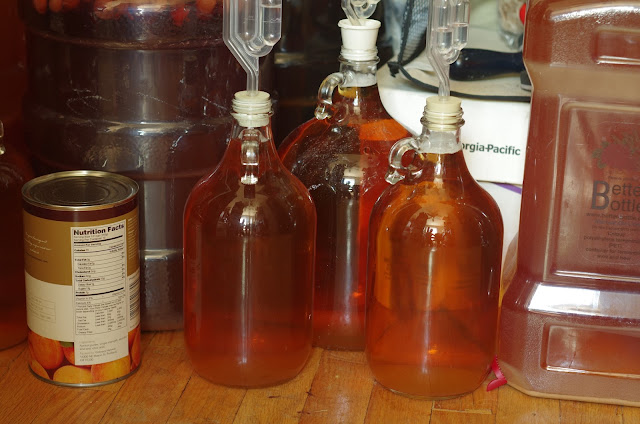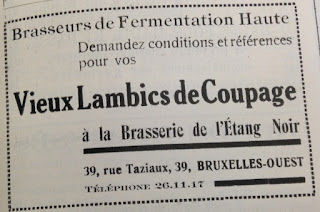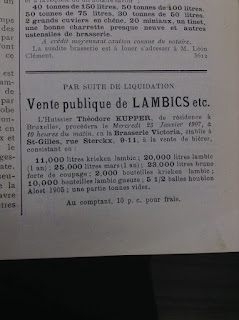For this next post in the series on
bière de coupage, I'm going to try to summarize my experience to date of making such beers with aged sours, and talk about some recent batches made with this process.
For a while I thought that
coupage was something brewers did after primary fermentation. That's certainly true of most
contemporary versions, but Dave Janssen directed me towards some material that suggests that this wasn't the only process used by earlier brewers. Some of the details are still unclear, but at least some of the material that Dave has passed on to me suggests that in some cases a small portion of aged beer was added at the
beginning of fermentation, rather than after primary fermentation was complete. This practice is often mentioned in connection with seasonal brewing, and its a running theme that
coupage is a necessity if brewing in the summer. This fits with the idea that the aged beer was used to steer fermentation in the right direction, by inoculating with bacteria and yeast that had proven themselves to make a positive flavour contribution, and also perhaps by lowering the pH of the wort to a point that would inhibit spoilage organisms in the early stages of fermentation. (I do not mean to suggest that the brewers understood it in exactly these terms.) This process is closer to
using aged beer to inoculate a solera than it is to
using it to contribute particular flavours to a blend.
The way I typically use aged sours is somewhere between these two practices. My primary purpose is to modify the flavour of the young beer, adding some aromatic complexity and a degree of tartness. But I also want the blend to slowly evolve over time, as the bacteria and yeast from the aged sour gradually take over the flavour profile. For me, noticing how a batch gradually changes is one of the pleasures of home brewing, and I've started to think a lot about how to brew beers that will go through a positive evolution as they get older. I'll say a bit more about that below.
When it comes to choosing base beers for this kind of blending, I generally follow this advice from Garrett Crowell at Jester King: "Beyond both components of the blend being dry/done with fermentation, there aren't any special requirements for making biere de coupage [except perhaps] a nice level of acidity in the aged beer". Although this can be hard to predict, I think the most important thing is to have some picture of where you want the final blend to end up. I like this general advice from Ron Jeffries, found in
Brew Like a Monk, even if its a little harder to apply to blended beers
:
Key in writing a great recipe [or making a great blend!] is to begin with the end. You must begin with the finished beer. You need a very clear vision of the beer you wish to brew. How does it look, what color is it? Does it glow; does it sparkle, or throw a yeasty haze? How does the head look, its color, texture, and lacing. Breathe in deeply through your nose. How does it smell? What does the aroma tell you about the beer? [Etc.]
Sometimes I want to accentuate and the fruitier flavours of a base beer with some tartness, and compliment them with some of the sharper citrus, hay, and overripe fruit you can find in aged sours, so I look for beer that I think will pair well to this effect. Other time I want to add a soft layer of barnyard funk and a lighter tartness to complement a more phenolic or earthy-hop-driven saison, so I'll use a blending component that I know has some of these aromas and flavours. Over time I've found myself preferring base saisons with a fairly clean fermentation profile, since I now want any brettanomyces-related funk to emerge slowly after blending. I also don't mind a bit of bitterness, even when blending with a tart beer, since what I want is for the balance between this bitterness and the tartness of the sour to gradually shift as the beer ages. My guide here is Yvan de Baets' description of Rodenbach-era
XX Bitter: "When young, the bitterness predominated, balanced by a light tartness. As it aged, the bitterness diminished, giving way to a more pronounced and lightly vinous tartness."

Using dry/fully-fermented beers is certainly the easiest way to make these blends, and I take the usual steps to ensure that the base beer finishes as low as possible (step mash, plenty of oxygen, healthy yeast). My saisons can end up anywhere between 1.006 and 1.000, depending on the blend of yeast I'm using, and the aged sours are typically in a similar range. If I want to blend straight-away without worrying about over-carbonation I try to get the saison as dry as possible. One way to do that is to use a highly attenuative strain like Wyeast 3711, which can take a beer down to 1.000 or lower. I'm not a big fan of the flavours from that yeast, but one technique I've used with some success is pitching a small proportion of an attenuative strain along with my primary yeast. A dried yeast like Danstar's Belle Saison is a good candidate here, because you can weigh out a tiny pitch and seal up the packet with a vacuum-sealer. Another option, if you're planning to let the beers age a bit before blending, is to pitch some brettanomyces along with the saison yeast. I still do this if I know the beers are going to sit for a while, but in general I want the base beer to have a relatively clean flavour profile at blending, so that the brettanomyces can gradually make its presence felt as the beer ages, rather than dominating from the start.

Most of the
bières de coupage I've made at home have used a pale sour from
one of my various soleras for the sour component of the beer. Whenever I take a draw from a solera, I put some of it in gallon and half-gallon glass jugs to save it for this kind of blending. In the past this has meant that I've varied the final proportions of a blend based more on convenience than tasting considerations. If I'm planning to blend in a five gallon carboy, I'll make four gallons of saison and blend it with a one gallon jug of pale sour in the carboy. That gives me a blend of 20% sour to 80% saison. If I'm making a smaller batch, I'll usually make three gallons of saison, move it to a carboy, and then rack out and replace some proportion with the sour. In some cases, this means racking out to fill a 1/2 gallon jug, and replacing with the same volume, i.e. roughly 15% sour to 85% saison. In other cases, I've split a single half-gallon jug between two three gallon carboys, i.e. roughly 8% to 92%.
I can't always predict the final profile of the beer based on the way it tastes at blending. One reason is that, if there is enough residual gravity left in either beer, there may be further fermentation afterwards. Depending on the age of (and relative health of the yeast and bacteria in) each beer, the sourness will either increase rather quickly after blending, or increase more slowly in the bottle. As with the
blends made with my kettle sour, I've found that a small amount of acidic beer makes a quite noticeable difference to the perception of the final blend. I would hesitate to go over 20-25% sour beer, unless I wanted to make something with a very pronounced acidity. 5-8% seems to be a good proportion for a background tartness, and 8-15% if you want something a little more pronounced without making the beer 'sour'. Of course, all of this will be relative to the sourness of your acid beer, as well as your own palate.
So far I've usually let the beer sit in the carboy for at least a month before packaging, which gives it a chance to stabilize. I have occasionally made
blends at bottling, and its something I'd like to do more frequently. The trick, of course, is getting a predictable level of carbonation after packaging, which means either ensuring that both components are as dry as possible before blending, or factoring in any further fermentation into how you calculate the amount of priming sugar. (Jeffrey Crane's
calculator is an excellent tool for this, but only if you can predict the terminal gravity of both components of the blend.) The most interesting option---one that's
inline with what many Belgian producers do---would be to rely solely on residual sugars in the blend for carbonation. I haven't been brave enough to try this yet, but its something I'd like to do in future. It certainly requires more patience, as the beer will need a longer period in the bottle to reach condition. There is also the fear that the beer will over-carbonate, or fail to carbonate at all.
Old Batches
While writing this post, I took the opportunity to revist some previous batches of b
ière de coupage. One recipe for which I've used this technique consistently is my
buckwheat saison. This is one of those beers where I'm looking for a more pronounced tartness to complement the fruit-forward flavours of the base, so five of the six batches I've made have had a ratio of 20% sour beer to 80% saison. Some of the saisons underwent mixed primary fermentations, whereas other were fermented clean.
The batch I tried while writing this post was the third I made, and is almost a year old at this point. It is very fruit-forward in its aroma and flavour, with lots of lemon up front (both in the flavour and acidity), and some more generic citrus and stone-fruit in the background. The buckwheat still gives this one a fairly full body, along with great head retention, but the beer still finishes dry. Its been pretty well received by most people I've given it to, and is one of my favourite batches.
The second was one of the
spelt saisons I brewed a few months ago. This one was aged with a small pitch of the Dupont Lochristi blend, and had approximately 1/4 gallon of ages sour blended in, to make up 8% of the final blend. Both beers were fairly attenuated at blending, and I let the blend sit for a while before packaging, at which point it had reached 1.002. I had hoped it might drop a little further in the bottle, but there's no sign of that yet.
At this point the beer has a noticeable tartness, but not one that dominates the rest of the beer. There's is also still a slight tannic bitterness at the back end, which I rather enjoy, since it adds a bit of complexity to the finish. The Lochristi strains are recognisable in the aroma and flavour of the beer, giving a soft fruitiness that is accentuated by the tartness. My biggest criticism of the beer is that it is only moderately carbonated, where higher carbonation (modified by the softer mouthfeel of the spelt) would really help some of the flavours to pop out. If I were to make this batch again, I would add the Lochristi strains along with the aged sour (or use a sour that had some of those strains), and package the beer at blending. My hope would be that the flavour profile would gradually shift over time, and that the carbonation would steadily increase without becoming dangerous.
New Batch
While working on this series of posts, I also decided to make a
bière de coupage that was a little different from the ones I've made before. For the most part, I've tended to stick to fairly classic saison profile for the blended components, particularly in their hop profile. This time I decided to go in a different direction, taking my basic spelt saison recipe, but using American hops for the flavour additions instead of something like EKG. In the end, I went with Ahtanum, Amarillo, and Citra for the kettle hops (keeping additions fairly small), as well as a light dry-hop with Amarillo.
I blended in a small portion of aged sour from a pale solera as I racked the beer to secondary (probably around 5%, though I did it by eye), and let it sit for a few weeks before adding the dry-hops. Once these had settled, I tasted the beer in preparation for bottling. The dry-hop had given it a very perfumed aroma, with lots of citrus and tropical fruit, and a touch of funk underneath it. This seemed promising, but I decided that the beer needed more tartness to make all of this jump out in the flavour. With that in mind, I added an extra 1/2 gallon of aged sour to the batch at bottling (in the photo below, you can see the parts of the dislodged pellicle spiralling down through the glass jug). I will give the beer at least three weeks before opening a bottle, and won't drink most of the batch until after I return from England at the end of the summer. It will be interesting to see how much of the hop aroma survives at that time.

Grist: Pilsner (65.7%), Unmalted Spelt (23.9%), Vienna (10.4%)
Hops: EKG, Amarillo, Ahtanum, Citra
Yeast: Saison Blend (Yeast Bay Saison Blend II, Wyeast 3726)
O.G.: 1.046
IBUs: 28.1
ABV: 5.8%
That's it for this post. In the next part of this series, I'll be writing about some rather special bières de coupage, made from home-brew blended with genuine lambic.
 For the first beer, I wanted to make a sort of bière de garde, in the literal sense of a beer intended for ageing. To this end, I planned a recipe with a slightly higher gravity than I'd usually aim for in a saison, 1.054. (I bet there was a time when that O.G. would have been lower than 90% of the saisons brewed in the U.S!) I went with a simple grist of 90% pilsner malt and 10% wheat, since the main focus was going to be the hops and the fermentation character, though I also did an extended three-hour boil to add a bit of colour and complexity.
For the first beer, I wanted to make a sort of bière de garde, in the literal sense of a beer intended for ageing. To this end, I planned a recipe with a slightly higher gravity than I'd usually aim for in a saison, 1.054. (I bet there was a time when that O.G. would have been lower than 90% of the saisons brewed in the U.S!) I went with a simple grist of 90% pilsner malt and 10% wheat, since the main focus was going to be the hops and the fermentation character, though I also did an extended three-hour boil to add a bit of colour and complexity.














